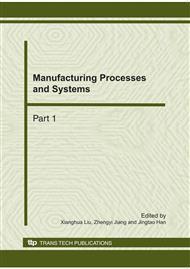p.136
p.141
p.147
p.152
p.157
p.163
p.168
p.172
p.177
Study on the Stability in Laser Cladding Forming Process of Thin-Wall Structures
Abstract:
The parameters obtained in the study of single layer of laser cladding forming are not suitable for the forming of actual structures. The cooling condition varies with the height of clad layers, which result in instability and then failure of cladding. Therefore, the stability of laser cladding forming is of significance. In this paper, melt pool depth is used as a criteria for stability. And the effect of processing parameters such as laser power and laser velocity on melt pool depth, are investigated by numerical simulation method. The results unveil that there is a transition zone from the beginning to stable stage during laser cladding forming. In the transition zone, laser power should be decreased or laser velocity should be increased to maintain the constant melt pool depth and to ensure the former clad layer would not be remelt. The optimized processing parameters are obtained for stable processing for a thin flat wall and a cylindrical wall, which successfully guide the manufacturing of the real structures.
Info:
Periodical:
Pages:
157-162
Citation:
Online since:
October 2010
Authors:
Price:
Сopyright:
© 2011 Trans Tech Publications Ltd. All Rights Reserved
Share:
Citation:


